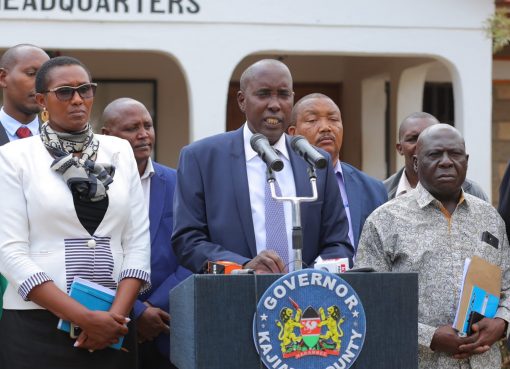Land degradation in Kenya has been increasing rapidly from 12 per cent in 1990 to 28.3 per cent of the total land in 2012, costing the country an annual estimated loss of Sh 180 billion, which is about five per cent of the country`s Gross Domestic Product (GDP).
To this end, the Ministry of Water, Sanitation and Irrigation through the State Department for Irrigation is working on a policy to help stem degradation.
The Director, Climate Change Resilience for Food and Water Security at the Ministry of Water, Sanitation and Irrigation Ian Thandi said the Bill seeks to help the country reclaim degraded land, noting that Land degradation is increasing in severity and extent in many parts of the world, with more than 20 per cent of all cultivated areas, 30 per cent of forests and 10 per cent of grasslands undergoing degradation.
He said this manifests itself as sustained loss of vegetation and landscape functions, increasing incidences of aridity, food insecurity, and increasing scarcity of water sources, shrubs in areas which were predominantly rich in pastures, gullies, thin and stony soils, and invasion of alien or intrusive species such as prosopis juliflora which is popularly known as “Mathenge”.
Githae was speaking in Naivasha during an ongoing five-day workshop that brings together experts to polish up the Draft Land Reclamation Bill which has already undergone public participation. The workshop ends on Friday when the experts are expected to have dealt with the grey areas in the Bill.
Githae noted Land that is an important socio-economic resource with multiple uses critical to the economic, social, and cultural development of this country, but the demand and pressure on land resources is rising mainly driven by the increasing rate of population growth, economic development and demand for food and shelter, thereby resulting in degradation of this important resource.
“This manifests itself as sustained loss of vegetation and landscape functions, increasing incidences of aridity, food insecurity, and increasing scarcity of water sources, shrubs in areas which were predominantly rich in pastures, gullies, thin and stony soils,” he said.
This necessitates remedial actions hence the advent of Land reclamation designed as a process of rehabilitating, restoring or improving degraded land to support a specified end use.
According to Githae, addressing land degradation is crucial to prevent decline in land productivity, water availability, and increased aridity and to secure our food security and social economic development, hence this Draft Land Reclamation Bill.
He emphasised that the main purpose of the Draft Bill is to facilitate accelerated and sustainable reclamation of degraded and waste lands and secure land degradation neutrality for food and water security, environmental sustainability and socio-economic development.
“This Draft Policy is designed as an overarching national framework that will guide the national and county legislations, other governance structures and stakeholders on recovery and restoration of degraded lands,”
He stated that the Government has been undertaking Land reclamation activities since the 1970s, but this has faced a serious obstacle as there has been no policy or legal framework to guide its actions.
“Consequently, there is lack of a coordinated, inter agency and sector wide approach to land reclamation and control of land degradation. This compounded with the lack of an enabling environment with limited investment having resulted in little progress on the Land Reclamation Agenda,” Githae stated.
He observed that the multiplicity of actors in the subsector requires a regulatory mechanism to ensure standards and sustainable actions and this forms the basis for the coordination and regulatory framework proposed in the draft policy.
The main objective of the Draft Bill is to facilitate accelerated and sustainable reclamation of degraded and waste lands and secure land degradation neutrality for food and water security, environmental sustainability and socio-economic development.
It will also provide an overall framework to guide Land reclamation initiatives, development and implementation of standards, legal, institutional and regulatory frameworks for land reclamation and land degradation neutrality across the country and to further halt degradation mainstream sustainable land management and climate actions for community resilience and ecosystem services.
It will also coordinate the planning, implementation, monitoring, evaluation and reporting of land reclamation strategies for enhanced synergy among stakeholders both at the national and county levels and promote greater resource mobilization and investments for land reclamation including land degradation neutrality.
“This draft policy addresses the following key areas; Actions to halt further land degradation, restoration of degraded lands, building requisite capacity through research and innovation, putting in place the enabling environment through appropriate institutional establishment and most importantly securing the necessary resources needed to undertake Land reclamation activities,” the director summed up his speech.
Through land reclamation, the government intends to put more land into irrigation and other uses in order to improve food security and boost the economy of the country. Currently, 747,000 acres are under irrigation, with 83,000 acres developed in the last two years alone
The Kenyan Government through the National Irrigation Sector Investment Plan (NISIP) launched last month has funded 228,731 acres under irrigation across 44 counties. This includes 147,131 acres under smallholder/community irrigation projects and 80,600 acres from the rehabilitation and expansion of gazetted schemes. Kenya targets 69 per cent expansion of irrigated land by 2027.
The NISIP is a comprehensive 10-year strategy developed by the Kenyan government to expand and modernize irrigation systems across the country, aiming to boost agricultural productivity, enhance food security, and attract private investment into the irrigation sector.
The plan aims to increase irrigation coverage from 22 per cent to 50 per cent, with a phased approach concentrating on prevailing infrastructure in the first two years.
Government aims to increase the irrigated area from 711,993 acres to 1.2 million acres by 2027, a whopping 68.5 per cent. The country’s irrigation potential stands at 1.342 million hectares but only 120,503 hectares have been developed.
Kenya’s food production is largely reliant on rainwater which renders it very vulnerable to weather variability and climatic changes.
By Mabel Keya- Shikuku





